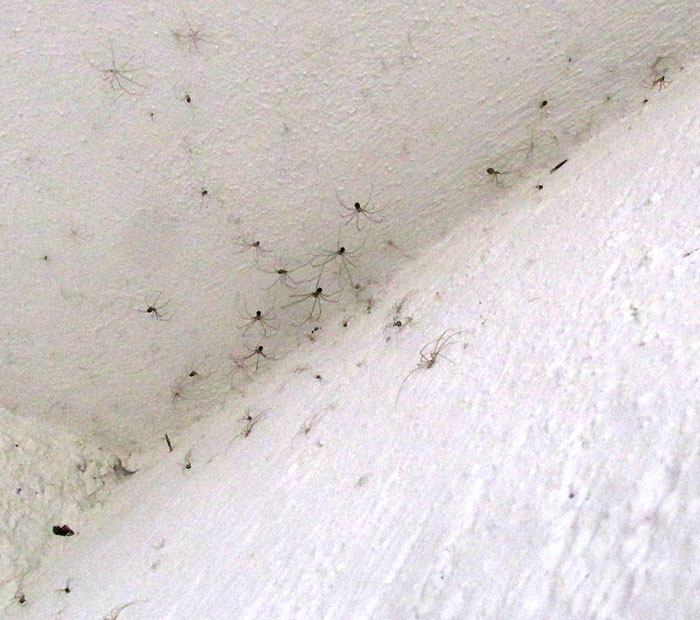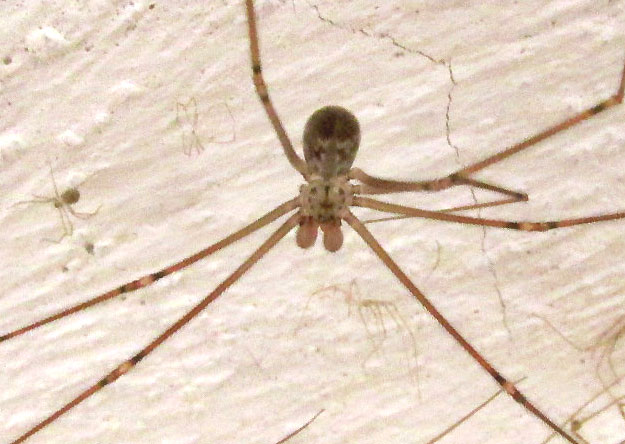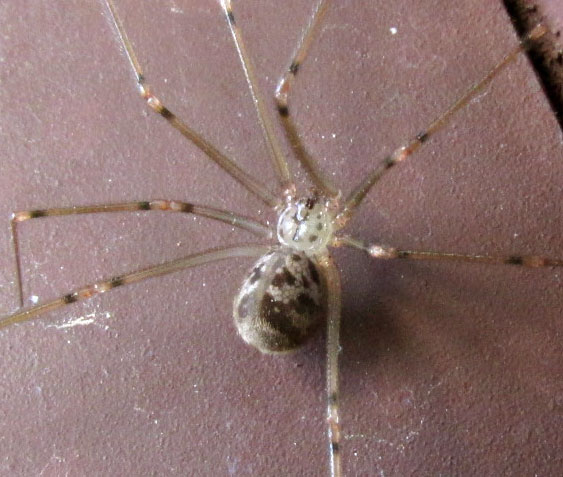Excerpts from Jim Conrad's
Naturalist Newsletter
entry dated December 24, 2022, issued from near Tequisquiapan, elevation about 1,900m (6200 ft), N20.565°, W99.890°, Querétaro state, MÉXICO
SHORT-BODIED CELLAR SPIDER

In the top corner of an otherwise neat outside bathroom with white-stuccoed interior walls, built beneath a staircase descending into the backyard, the above little community of spiders of different sizes have taken up residence. At the picture's top, left corner, some pale, almost transparent "skins" shed during molting, the exuvia, can be seen. Up close, patterns on the legs, abdomen and the carapace become apparent:

The carapace is the top, or dorsal part, of the cephalothorax, which is the front section of a spider's body, the head and thorax fused into one section. In insects, the head and thorax are separate divisions. On the carapace of the larger spider in the above picture, the dark middle splotch is vaguely shaped enough like a violin that I assumed that these were deadly Brown Recluses, sometimes known as Fiddleback Spiders, Brown Fiddlers and other such names. Brown Recluses, genus Loxosceles, occur in such human-occupied environments, are brown like these spiders, and long-legged. However, as of 2022 about 143 Loxosceles species are recognized worldwide, with maybe 41 occurring in Mexico, so which species are these? Knowing that closer pictures were needed for an identification, in the bathroom's dim light, this is as close as I could focus:

The carapace's center design looks more like an anchor than a violin, but then only a few species of Loxosceles species have carapace designs really looking like violins, though the main species in the Eastern US does.
One of the larger spiders, disturbed by my camera poking into the corner, escaped to outside the bathroom , clung to the door and afforded a closer look:

In that picture, instead of an anchor, this individual's carapace design looks more like a tuning fork or slingshot. Apparently these "fiddles" look different, probably varying from molt to molt.
I couldn't match our spider with any picture of Mexican Loxosceles species. Therefore, I browsed spider families at BugGuide.Net, where a family of spiders similar to the Brown Recluses turned up, the Cellar Spider Family, the Pholcidae, embracing over 1800 species worldwide. They're pale brown, display long, slender legs, can have splotches of various forms on their carapaces, and often inhabit human buildings. BugGuide.Net is smartly designed so you can browse pictures of species in various genera within a family. That process let me to the genus Physocyclus. Further browsing of BugGuide.Net's species of Physocyclus brought me to PHYSOCYCLUS GLOBOSUS, sometimes known as Short-bodied Cellar Spiders.
And Physocyclus globosus does commonly occur in Mexico, as well as the tropics worldwide, and here and there into the Temperate Zone, as shown on the distribution map of GBIF.Org's Physocyclus globosus page. The genus Physocyclus is home to about 34 species, of which 32 are native to Mexico, its center of distribution. Of the genus, only one species occurs worldwide in warm areas, and that's this one, Physocyclus globosus.
Physocyclus globosus, like other species in the Cellar Spider Family, hang bottom-up in irregular-shaped, rather messy and disorganized looking webs. A tangle of strands is formed above a domed sheet web. Web strands are not sticky, but they are hard to see. Prey bump into strands, causing vibrations enabling the spider to locate it and quickly demobilize it within a cocoon of silk-like material, before inflicting the fatal bite. The prey may be eaten immediately, or stored. When feeding is finished, the spider drops the carcass to the ground. The venom of cellar spiders is not regarded to be dangerous to humans.
In the wild Physocyclus globosus inhabits caves and lives under rocks, sometimes beneath loose bark and in abandoned mammal burrows.
It's common knowledge that in some spider species the larger female eats the smaller male after mating, taking advantage of the male's nutritive value. In a 2019 publication by Luis F. de Armas and Abel Pérez González, entitled "Physocyclus globosus: Canibalismo no sexual y depredación de inmaduros de Phormictopus cubensis (Araneae: Pholcidae, Theraphosidae)," two cases of "non-sexual cannibalism" are reported for Physocyclus globosus, as well as our spider feeding on the first nymphal stage, or instar, of a Cuban spider species.